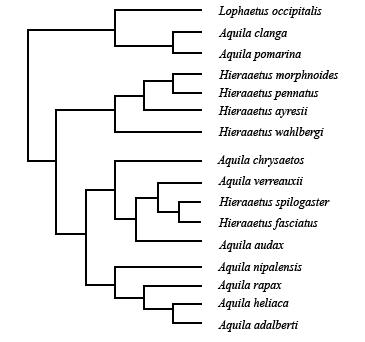Classification
Domain-Eukarya
This domain is classified by the presence of a nucleus and
membrane bound organelles, which the Golden Eagle’s cells contain.
This is a very broad category.
Kingdom-Animalia
This kingdom’s organisms are multicellular and heterotrophic.
They also lack a cell wall.
Phylum-Chordata
This means the animal has a spinal chord. It
is also classified in this category because of its three layers of
tissue (triploblastic) and its lateral symmetry.
The Golden Eagle also has a complete digestive tract, which is
typical of animals in this category.
Class-Aves
This is a broad category of birds. These
birds are all warm blooded with an exoskeleton of feathers.
They have no teeth present, and they also have no sweat glands.
This encompasses a wide range of birds, from the parrots of
the tropics to the small native birds of the plains.
Order-Falconiformes
Sharp beaks, raptor claws, and long wings for soaring flight are
what put the Golden Eagle into this category.
Others in this category include falcons and vultures.
Family-Accipitridae
Birds of prey will broad wings the main characteristic is the
presence of the cere. The cere is a waxy coat
that is located on the mandible of the bird and used for the nostril
openings.
Genus-Aquila
This encompasses all eagles and their species. Aquila is the
Latin word for eagle.
Species-chrysaetos
Chrysaetos is the Latin word for gold. The
Golden Eagle got its species name because of the gold/brown tuff of
feathers it has on the nape of its neck.
 This
phylogeny shows a simplified version of the separation of
species in the raptor family also based on the total nuclear and
mitochondrial DNA similarities. This tree
contains a closer look at the extant members of the family
Accipitridae (Helbig et al. 2009).
This
phylogeny shows a simplified version of the separation of
species in the raptor family also based on the total nuclear and
mitochondrial DNA similarities. This tree
contains a closer look at the extant members of the family
Accipitridae (Helbig et al. 2009).
Click on the very small tree on the right to enlarge
this tree, and
visit the link to the research which classified this eagle so it can
be viewed
in full size. Scroll to the body of the research article to
view this tree and the extensive explanation. This is an evolutionary tree that shows the relationship of
the family Accipitridae. Specifically what can be seen in the
relationship based on mitochondrial cyt-b of the Golden
Eagles to other similar raptor birds and vultures (Lerner and
Mindell 2005).
